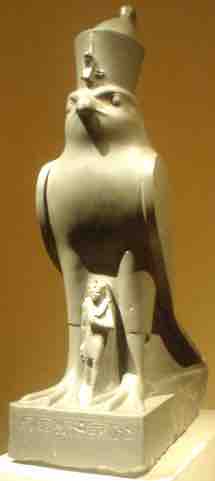The Late Period of ancient Egypt refers to the last flowering of native Egyptian rulers after the Third Intermediate Period from the Twenty-Sixth Saite Dynasty into Persian conquests, and ended with the conquest by Alexander the Great and establishment of the Ptolemaic Kingdom. It ran from 664 BC until 332 BCE. Though foreigners ruled the country at this time, Egyptian culture was more prevalent than ever. Libyans and Persians alternated rule with native Egyptians. Despite continued conventions in art, some notable changes in the human form did arise. The sculpture (pictured below) of the god Horus as a child (664–332 BCE) represents a combination of the typical stylized stance of Egyptian statuary with a fleshier body and pensive gesture of the right hand and arm.
Horus as a Child (664–332 BCE)
The Late Period is often regarded as the last gasp of a once great culture, during which the power of Egypt steadily diminished.
Twenty-Sixth Dynasty
The Twenty-Sixth Dynasty, also known as the Saite Dynasty, reigned from 672–525 BCE. Canal construction from the Nile to the Red Sea began. According to Jeremiah, during this time many Jews came to Egypt, fleeing after the destruction of the First Temple in Jerusalem by the Babylonians (586 BCE). Jeremiah and other Jewish refugees arrived in Lower Egypt, notably in Migdol, Tahpanhes, and Memphis. Some refugees also settled at Elephantine and other settlements in Upper Egypt (Jeremiah 43 and 44). Jeremiah mentions pharaoh Apries (as Hophra, Jeremiah 44:30) whose reign came to a violent end in 570 BCE. This and other migrations during the Late Period likely contributed to some notable changes in art.
One major contribution from the Late Period of ancient Egypt was the Brooklyn Papyrus. This was a medical papyrus with a collection of medical and magical remedies for victims of snakebites based on snake type or symptoms.
Brooklyn Papyrus (c. 450 BCE)
This papyrus provides the most striking evidence for the closely parallel roles of the physician swnw and the various priests concerned with healing.
Artwork during this time was representative of animal cults and animal mummies. The faience sculpture below shows the god Pataikos wearing a scarab beetle on his head, supporting two human-headed birds on his shoulders, holding a snake in each hand, and standing atop crocodiles. The style of this sculpture marks a departure from its predecessors in its fleshiness, positioning of its arms and hands, and slight smile.
Figure of Pataikos (664–630 BCE)
This glazed faience sculpture of the god Pataikos shows a somewhat naturalistic departure from traditional depictions of Egyptian deities.
Despite the changes that took place in the sculpture of Pataikos, artists continued to use the traditional canon of proportions. A sunken relief from a chapel at Karnak depicting Psamtik III, the final pharaoh of this dynasty, displays the maintenance of traditional conventions in representing the body.
Relief of Psamtik III at a chapel in Karnak
Despite changes in the sculptures of Horus and Pataikos, this image of the last pharaoh of the Twenty-Sixth Dynasty appears in the more traditional stylized form.
Twenty-Seventh Dynasty
The First Achaemenid Period (525–404 BCE) marked the conquest of Egypt by the Persian Empire under Cambyses II. In May 525 BCE, Cambyses defeated Psamtik III in the Battle of Pelusium in the eastern Nile Delta. This basalt portrait bust (pictured below) of an unknown Egyptian dignitary from the period shows little change from convention in the representation of the human form. His necklace is typical of those made in the Achaemenid Period.
Statue of an Egyptian dignitary from the Twenty-Seventh Dynasty
The necklace on this dignitary has been identified as typical of the era of Persian occupation.
Twenty-Eighth through Thirtieth Dynasties
The Twenty-Eighth Dynasty consisted of a single king, Amyrtaeus, prince of Sais, who rebelled against the Persians and briefly re-established indigenous Egyptian rule. He left no monuments with his name. This dynasty reigned for six years, from 404–398 BCE. The Twenty-Ninth Dynasty ruled from Mendes, from 398–380 BCE.
The Thirtieth Dynasty took the art style from the Twenty-Sixth Dynasty. A series of three pharaohs ruled from 380 BCE until their final defeat in 343 BCE led to the reoccupation by the Persians. Art featuring Nectanebo II, the final ruler of this dynasty, appears largely in the traditional Egyptian style. Except for the small-scale greywacke (sandstone) statue in the Metropolitan Museum, which shows him standing before the image of Horus as a falcon, no other annotated portraits of the pharaoh are known.

Horus and Nectanebo II (360–343 BCE)
This is believed to be the only surviving annotated sculpture of the last pharaoh of the Thirtieth Dynasty.
A fragment of Nectanebo II's portrait, with its partial smile and sagging chin, in the Museum of Fine Arts in Lyon, is slightly more naturalistic than previous representations of pharaohs.
Head of Nectanebo II
This portrait features a combination of traditional and naturalistic features.